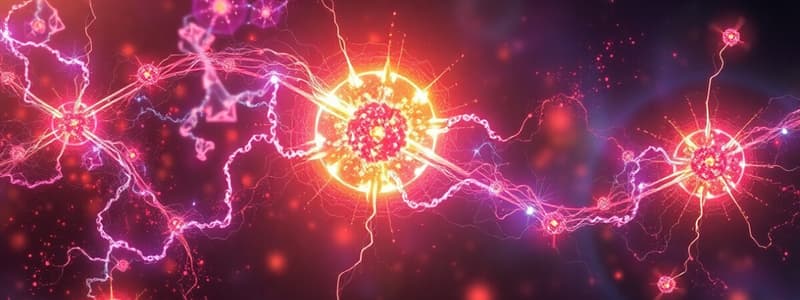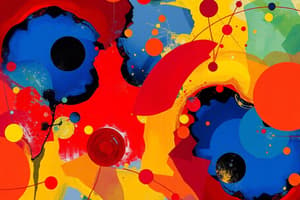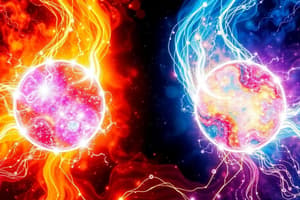Podcast
Questions and Answers
What does oxidation refer to in a chemical reaction?
What does oxidation refer to in a chemical reaction?
- The addition of hydrogen atoms
- The loss of electrons (correct)
- The gain of electrons
- The conversion of molecules to gas
How can one identify reduction in a chemical reaction?
How can one identify reduction in a chemical reaction?
- By identifying the gain of hydrogen isotopes
- By observing the loss of hydrogen atoms
- By seeing an increase in electron density (correct)
- By observing a decrease in molecular weight
In the reaction from methane to carbon dioxide, what process is methane undergoing?
In the reaction from methane to carbon dioxide, what process is methane undergoing?
- Decomposition
- Reduction
- Synthesis
- Oxidation (correct)
What role does water play in biological redox reactions?
What role does water play in biological redox reactions?
Which molecule is reduced in the overall reaction for aerobic respiration?
Which molecule is reduced in the overall reaction for aerobic respiration?
What is one implication of a molecule being reduced?
What is one implication of a molecule being reduced?
Which of the following statements about Nicotinamide Adenine Dinucleotide (NAD) is true?
Which of the following statements about Nicotinamide Adenine Dinucleotide (NAD) is true?
In redox reactions, what does the term 'reduced form' imply?
In redox reactions, what does the term 'reduced form' imply?
What happens to the electrons during the redox reactions in biological systems?
What happens to the electrons during the redox reactions in biological systems?
Which statement about the reaction C6H12O6 + 6O2 → 6CO2 + 6H2O is accurate?
Which statement about the reaction C6H12O6 + 6O2 → 6CO2 + 6H2O is accurate?
What role do NAD and FAD play in cellular respiration?
What role do NAD and FAD play in cellular respiration?
What is the reduced form of NAD?
What is the reduced form of NAD?
How do NADH and FADH2 function in cellular respiration?
How do NADH and FADH2 function in cellular respiration?
What happens to carbon dioxide during photosynthesis?
What happens to carbon dioxide during photosynthesis?
Which statement accurately describes FAD?
Which statement accurately describes FAD?
Which process involves the use of light energy to convert carbon dioxide and water into sugars?
Which process involves the use of light energy to convert carbon dioxide and water into sugars?
What occurs when NAD+ accepts electrons?
What occurs when NAD+ accepts electrons?
What does the electron transport chain do with the electrons it receives?
What does the electron transport chain do with the electrons it receives?
What happens to NAD and FAD after they have donated electrons in the electron transport chain?
What happens to NAD and FAD after they have donated electrons in the electron transport chain?
Which of the following is NOT a characteristic of electron shuttles like NAD and FAD?
Which of the following is NOT a characteristic of electron shuttles like NAD and FAD?
Oxidation involves the gain of electrons.
Oxidation involves the gain of electrons.
During a redox reaction, the molecule gaining electrons is said to be reduced.
During a redox reaction, the molecule gaining electrons is said to be reduced.
Water is always present during redox reactions in biological systems.
Water is always present during redox reactions in biological systems.
In the reaction from methane to carbon dioxide, methane is reduced.
In the reaction from methane to carbon dioxide, methane is reduced.
The reduction of oxygen occurs when it gains hydrogens and becomes water.
The reduction of oxygen occurs when it gains hydrogens and becomes water.
The reduced form of a molecule typically has less potential energy than its oxidized form.
The reduced form of a molecule typically has less potential energy than its oxidized form.
Nicotinamide Adenine Dinucleotide (NAD) can exist in both oxidized and reduced forms.
Nicotinamide Adenine Dinucleotide (NAD) can exist in both oxidized and reduced forms.
Electrons in a biological system do not interact with hydrogen atoms.
Electrons in a biological system do not interact with hydrogen atoms.
Glucose is oxidized during the process of aerobic respiration.
Glucose is oxidized during the process of aerobic respiration.
Hydrogen atoms always increase the positive charge of a molecule when added.
Hydrogen atoms always increase the positive charge of a molecule when added.
NAD and FAD are primarily used for storing energy in the cell.
NAD and FAD are primarily used for storing energy in the cell.
NADH is the oxidized form of nicotinamide adenine dinucleotide.
NADH is the oxidized form of nicotinamide adenine dinucleotide.
FADH2 is produced during the Tricarboxylic Acid Cycle.
FADH2 is produced during the Tricarboxylic Acid Cycle.
The Electron Transport Chain is the final step of anaerobic respiration.
The Electron Transport Chain is the final step of anaerobic respiration.
During photosynthesis, carbon dioxide is reduced to form sugars.
During photosynthesis, carbon dioxide is reduced to form sugars.
NAD and FAD lose their electrons during Glycolysis.
NAD and FAD lose their electrons during Glycolysis.
FAD is reduced to FADH2 during the TCA cycle.
FAD is reduced to FADH2 during the TCA cycle.
NADH and FADH2 are both oxidized in the Electron Transport Chain.
NADH and FADH2 are both oxidized in the Electron Transport Chain.
NAD+ acts as an electron acceptor during glycolysis.
NAD+ acts as an electron acceptor during glycolysis.
FAD in its oxidized form is called FADH.
FAD in its oxidized form is called FADH.
Flashcards are hidden until you start studying
Study Notes
Oxidation-Reduction Reactions (Redox)
- Oxidation is the loss of electrons.
- Reduction is the gain of electrons.
- Water is always present in biological reactions, and electrons pull hydrogen from water in their environment.
- You can follow the movement of electrons by tracking the hydrogen atoms in a reaction.
Example Redox Reaction
- Methane (CH4) is oxidized during a reaction, losing electrons.
- You can tell this because it loses its hydrogens.
- Oxygen (O2) is reduced, gaining electrons.
- You can tell this because it gains hydrogens.
- Water is the reduced form of oxygen.
Aerobic Respiration
- Glucose (C6H12O6) is oxidized while Oxygen (O2) is reduced in the overall reaction for aerobic respiration:
- C6H12O6 + 6O2 → 6CO2 + 6H2O
- Reduced molecules have more potential energy than oxidized forms of the same molecule.
Electron Carriers
- Cells use electron carriers to move electrons and their associated energy.
- NAD (Nicotinamide Adenine Dinucleotide) and FAD (Flavin Adenine Dinucleotide) are the primary electron carriers in aerobic respiration.
- NADH is the reduced form of NAD and carries extra energy.
- FAD is the oxidized form of FAD.
Electron Transport Chain
- NADH and FADH2 get oxidized during the electron transport chain.
- They act as shuttles, picking up electrons during glycolysis and the TCA cycle, and then delivering them to the electron transport chain.
- NAD and FAD themselves are not broken down, they simply cycle between their oxidized and reduced forms.
Photosynthesis
- Plants use light energy to convert carbon dioxide and water into sugars and oxygen.
- Carbon dioxide (CO2) is reduced during photosynthesis as it is converted to sugar.
Oxidation-Reduction Reactions (Redox)
- In redox reactions, oxidation is the loss of electrons, and reduction is the gain of electrons.
- Electrons in biological systems are usually accompanied by hydrogen ions (H+).
- Water is always present in cells and is important for tracking electron movement.
- When a molecule loses hydrogen ions, it is being oxidized.
- When a molecule gains hydrogen ions, it is being reduced.
Redox Reactions in Prokaryotes
- Methane (CH4) is oxidized to carbon dioxide (CO2) by losing hydrogen atoms (electrons).
- Oxygen (O2) is reduced to water (H2O) by gaining hydrogen atoms (electrons).
Glucose Oxidation and Oxygen Reduction
- In aerobic respiration, glucose (C6H12O6) is oxidized to carbon dioxide (CO2), and oxygen (O2) is reduced to water (H2O).
- The reduced form of a molecule generally has more potential energy than its oxidized form.
Electron Carriers: NAD and FAD
- Nicotinamide adenine dinucleotide (NAD) and flavin adenine dinucleotide (FAD) are electron carriers in aerobic respiration.
- NAD and FAD transport electrons, and thus potential energy, during glycolysis and the tricarboxylic acid cycle (TCA cycle).
- NADH and FADH2 are the reduced forms of NAD and FAD, respectively.
- NADH and FADH2 are oxidized during the electron transport chain.
- FAD is the oxidized form.
Photosynthesis
- During photosynthesis, plants use light energy to convert carbon dioxide (CO2) and water (H2O) into sugars and oxygen (O2).
- Carbon dioxide is reduced to sugar (glucose) by gaining electrons.
Studying That Suits You
Use AI to generate personalized quizzes and flashcards to suit your learning preferences.




